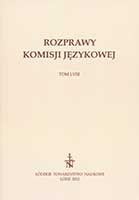Realizacja spółgłosek tylnojęzykowych w polszczyźnie południowokresowej XVII–XVIII w. (na materiale epistolarnym)
Realisation of dorsal consonants in the Polish of the Southern borderland of the 17th and 18th century (based on epistolary texts)
Author(s): Katarzyna SicińskaSubject(s): Language and Literature Studies
Published by: Łódzkie Towarzystwo Naukowe
Keywords: history of Polish; dialectology; Polish language of the 17th–18th century; the Polish of the borderland; dorsal consonants
Summary/Abstract: One of the distinctive features of the Polish of the Southern borderland which has not been unambiguously explicated is palatality of dorsal consonants k, g before ę and before e of secondary derivation (e < ę) as in ręAe, w dro)e, )ęsty, Aempa, as well as palatalised articulation of the ,e, ,y group, as in mu-e, -iba, su-i, together with hypercorrection resulting from this type of articulation. The phenomenon can be accounted for in two major ways. The first hypothesis is that its origin is domestic, Mazovian, and according to the second hypothesis it is the result of influences from Ukrainian dialects. The linguistic material presented in the paper, coming from epistolary texts produced in the 17th and 18th century in the former territory of South-Eastern borderland, was juxtaposed with data from other Southern borderland sources and the results point to the thesis about Ukrainian influences.
Journal: Rozprawy Komisji Językowej
- Issue Year: 2012
- Issue No: 58
- Page Range: 301-316
- Page Count: 16
- Language: Polish

